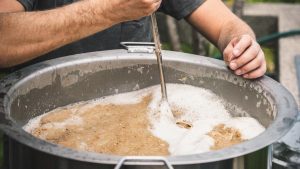All Grain vs Extract Brewing: Complete Guide for Homebrewers
 All grain vs extract brewing is a common comparison that homebrewers keep on making when figuring out what the best way is to make beer. If you’re new to homebrewing, you probably have this question too, which is what we would answer in this guide.
All grain vs extract brewing is a common comparison that homebrewers keep on making when figuring out what the best way is to make beer. If you’re new to homebrewing, you probably have this question too, which is what we would answer in this guide.
This guide will cover all you need to know about all grain and extract brewing, from the equipment and recipes to the advantages and downsides of the methods. Keep on reading to find out more.
What Are The Differences Between Extract vs All Grain Brewing?
The main difference between all-grain and extract beer brewing is the method in which you get fermentable sugars during the process. Keep in mind that beer is made with grains, yeast, water and hops but the fermentation process is different for various brewing types.
Further Comparing The Two Fermentation Processes
All-grain brewing is the traditional and professional method of making beer, which involves the use of crushed malted grains. These are mashed with hot water, thus turning the starches into fermentable sugars. This would then ferment into beer.
But with extract brewing, this process is done by a manufacturer and added in a powdered (dry malt) or liquid (liquid malt) form. The extract used for brewing is made by suppliers and sold to homebrewers. So, you can save time on converting the starch to fermentable sugars and jump right into the brewing.
This is why the all-grain method seems longer and more complicated than the extract, and has a wide margin of error. You would have to practice with this type of brewing before you get the hang of it. If you’re not confident with your skills or you’re a beginner, it’s best to start with the simpler method.
Aside from this basic difference, they also differ in price. While you spend more money on equipment for all-grain brewing, you would also have to purchase the malt extract for extract brewing, which is also expensive.
The time put in the two brewing methods also differs. You have to spend an entire hour more on all-grain brewing than extract, and this is something good to consider. It all goes down to comparing both brewing methods and choosing one that works for you.
What Is All Grain Brewing Best For?
All grain brewing involves using only grain, and it’s a process best for you to influence the taste of your beer depending on how you make it. The method is also used by professional brewers, making it a “purist” way of brewing beer.
To brew all grain beer, you use crushed grains to make the beer from scratch. The process begins with mashing, which is the practice of soaking the crushed grains for one hour. This would extract the sugars from the grain.
The grains are soaked in strike water with a temperature between 145 and 158 degrees Fahrenheit. The exact temperature used depends on the features and style of the beer; if you want beer with a sweet finish, you use a high temperature. On the contrary, lower temperature leads to dry finished beers.
– Equipment
There are different kinds of equipment needed when brewing all grain beer. You can choose between single, dual or three-vessel systems. As the name implies, they differ based on how many brew kettles you use for each process. When choosing either one, you should consider their advantages, disadvantages and how expensive they are.
Firstly, a single vessel system involves using only a brew kettle for the entire process. It’s a perfect choice for beginners who want to try all-grain brewing without spending too much on equipment. But, you will need a fine mesh grain bag to mash the grains and pull it out of the kettle before boiling.
Secondly, there is the two-vessel system, where you use two kettles. One brew kettle is for boiling and the other is for mashing. With a dual-vessel system, you don’t need a grain bag, making the process easier. It’s also safer, as pulling the grain bag can cause injuries.
Thirdly, you can go for the most advanced equipment in all-grain brewing, which is the three-vessel system. Here, you need three different brewing vessels. Each one is for heating sparge and strike water, mashing and boiling. With this equipment, you can enjoy precision and efficiency.
– Process
Follow the recipe below to brew your beer using the all-grain method. It takes up to three and a half hours to completely brew in a day.
- Soak the grains in strike water for an hour at between 145 and 158 degrees Fahrenheit.
- Sparge the grains with water at 168 degrees Fahrenheit. This step is optional.
- Pour all the fermentable wort into the boil kettle, depending on the equipment you’re using.
- Add the hops and let the mix boil for 60 minutes.
- Cool it down, pitch the yeast and let it ferment.
– Pros
- Brewing process is used by professionals
- It requires less expensive ingredients
- You can influence the outcome of the brew process
- The equipment needed is ideal for all knowledge levels
– Cons
- It takes more time than extract-brewing.
- It is a bit complicated and requires lots of practice.
What Is Extract Brewing Best For?
Extract brewing is best for beginners as it involves a simple process of malt extraction to make your beer. The process of brewing extract beer has probably been carried out by most homebrewers, as it is easy to start with for beginners, as we said. It is also more affordable than all-grain brewing, takes a shorter time and has only little room for error.
 There are two main ways to carry out extract brewing. For one, you can use dry malt extract in making your beer. On the other hand, you can use liquid malt extract instead. Despite this, the recipe or process of homebrewing the beer is similar. You simply mix it with strike water and let it boil for 60 minutes.
There are two main ways to carry out extract brewing. For one, you can use dry malt extract in making your beer. On the other hand, you can use liquid malt extract instead. Despite this, the recipe or process of homebrewing the beer is similar. You simply mix it with strike water and let it boil for 60 minutes.
While dry malt extract can be easily purchased the way it is, you would have to make your liquid homebrew extract. You do so by taking the mashed wort and letting it dehydrate until there is only 20 percent of water left. It has a syrup-like texture and looks like molasses. After this step, you can move on to the normal process which is explored below.
– Equipment
The equipment needed for extract brewing is way less complicated than that for the all-grain method. You simply need to purchase a beginner-friendly homebrewing kit and a single vessel measuring between 7 and 10 gallons. The latter would be used for boiling your wort. Keep in mind that this vessel size is ideal for making a five-gallon batch of extract beer.
– Process
The extraction process takes between two hours, plus two hours and thirty minutes to brew. You can do so with the recipe below.
- Steep your specialty grains in the bag at 160 degrees Fahrenheit. Do this for 20 minutes in the brew kettle.
- Remove the grains and add the liquid or dry malt extract, stirring it in.
- Boil for 60 minutes with the hops you added.
- Let the wort cool down, pitch the yeast and ferment your new extract beer.
– Pros
- It is easy and convenient to do
- Ideal for new homebrewers
- It takes less time and steps
- Requires minimal equipment to get done
– Cons
- You have less control over the outcome of your beer
- The liquid or dry malt extracts are expensive
Homebrewing for Beginners
Just as the name implies, homebrewing involves brewing beer in the comfort of your house and for personal purposes. The homebrewing community continues to expand today, and if you’re planning to be part of this, then you need a brewing method to start with.
To start homebrewing, you should purchase supplies like fermentation tanks and homebrewing kits. These are usually easily accessible at specialty stores online or close to you.
Next, figure out the type of brewing method you want to use, as we have explored the main two in this guide. Once you’re ready, you can follow the steps to make your beer at home.
Converting All Grain to Extract Recipes
If you prefer working with extract brewing, it would be a bit frustrating to look for new brewing recipes, only to see that they are for all-grain methods. But, you still have something to work with. You can convert all grain to extract by checking the recipe of the former and applying it to the latter.
Firstly, figure out what base malt is included in the recipe. Some popular base malts include pale, pilsner, 6-row, 2-row, rye, Maris Otter and wheat. Luckily for you, you can easily find a malt extract alternative for any kind of base malt.
Now that you have your base malt, you need to convert it to either liquid or dry malt extract. All grain recipes usually list a percent of efficiency, which stands for how much fermentable sugar can be extracted when mashing. So, when converting the amount of base malt needed, you should check the efficiency.
Keep in mind that liquid malt weighs more than the dry malt extract. For instance, if the mash efficiency in the recipe is 70 percent, the liquid malt extract would be 0.68 while the dry malt is 0.56. For 65 percent, it is 0.63 and 0.52; then 75 percent is 0.73 and 0.60. Finally, 80 percent mash efficiency is 0.78 and 0.64 for liquid and dry extract, respectively.
The last thing to do is make room for all the specialty grains you were planning to add to your extract beer. To do so, heat up the water to between 160 and 170 degrees Fahrenheit, and steep the grains in a muslin bag for thirty minutes. Then, pull it out and follow the extraction process normally.
Does All Grain Brewing Taste Better Than Extract?
No, all grain beer does not necessarily taste better than extract-based beer. In fact, more than half (57%) of beer consumers appear to have a preference for extract beer due to its sweeter taste.
However, some beer experts say that the all grain method leaves the true taste of malt unchanged. As such, you’re gonna get a beer that tastes lighter and possibly more watery, but with an adulterated touch of pure malt.
All Grain vs Extract Brewing: Which One Should You Choose?
 Now, the real question you might be asking yourself is which method you should choose. You can either go for the traditional and professional all-grain method, or stick to the casual and simpler extract brewing.
Now, the real question you might be asking yourself is which method you should choose. You can either go for the traditional and professional all-grain method, or stick to the casual and simpler extract brewing.
If you’re an experienced brewer, then you’ll have no trouble creating a delicious all-grain brew at first. Furthermore, it’s advisable for beginners to use the extract brewing method first to get the hang of homebrewing. Once you have, you can take the step up to all-grain brewing. It’s also important to buy a brew kettle that can work for extract or all-grain brewing, no less than 10 gallons. Finally, with this complete guide, you can start your homebrewing process with either of these two and enjoy your delicious beers.






